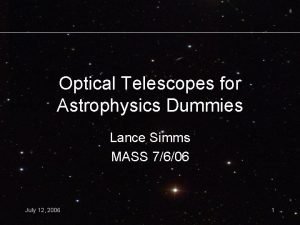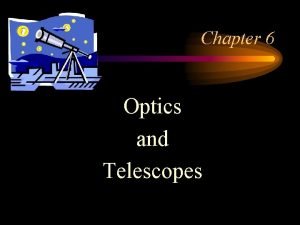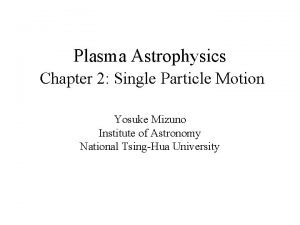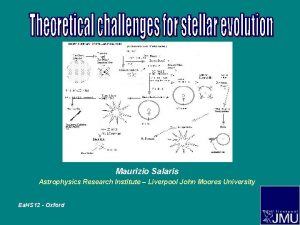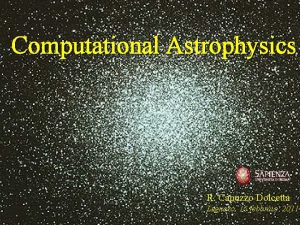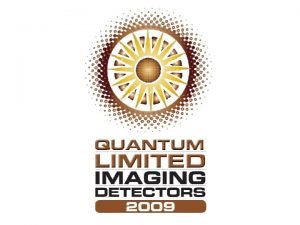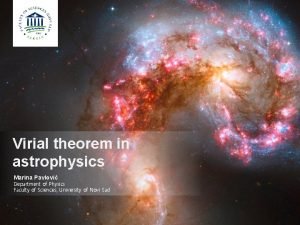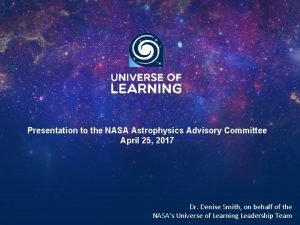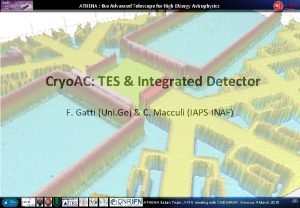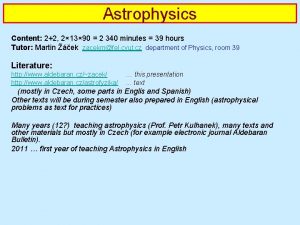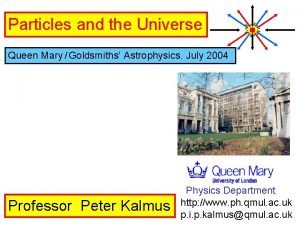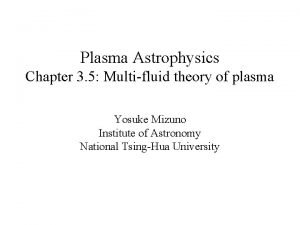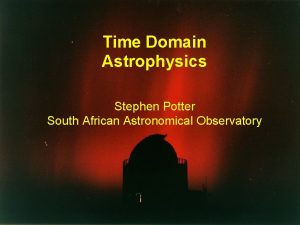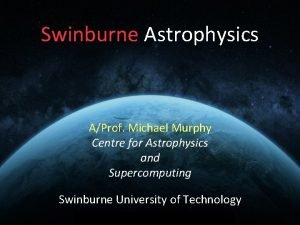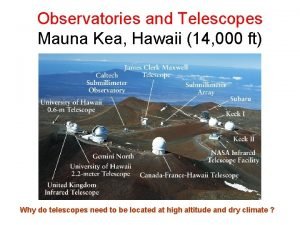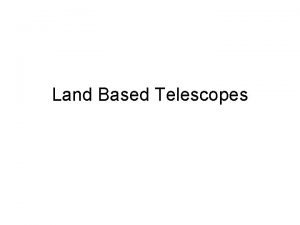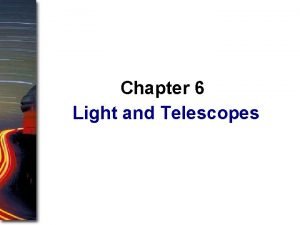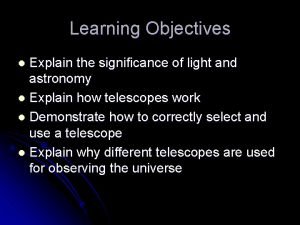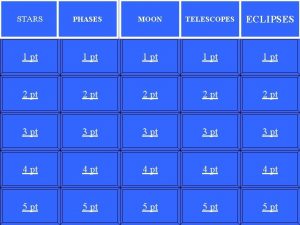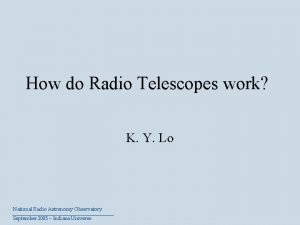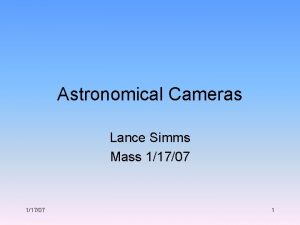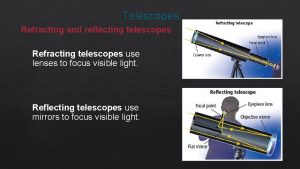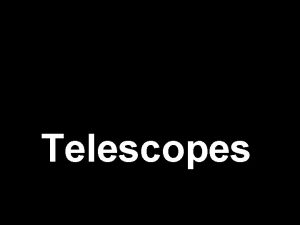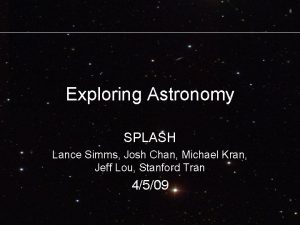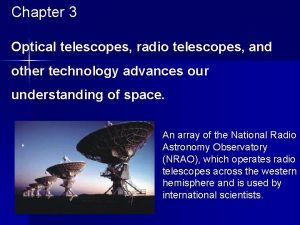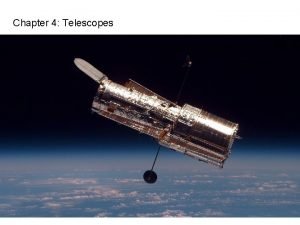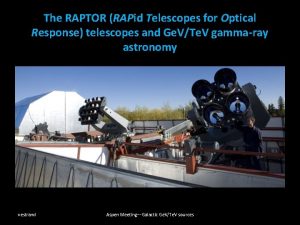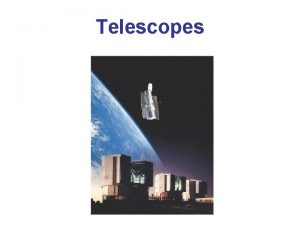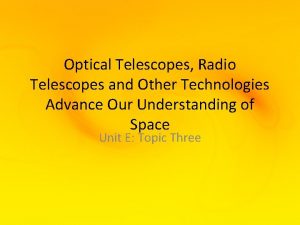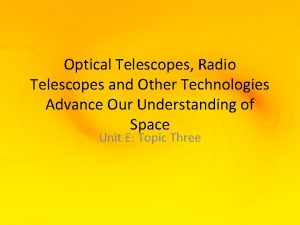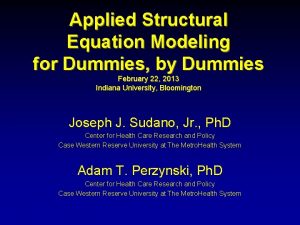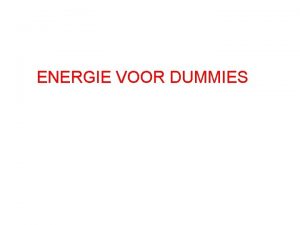Optical Telescopes for Astrophysics Dummies Lance Simms MASS





























- Slides: 29

Optical Telescopes for Astrophysics Dummies Lance Simms MASS 7/6/06 July 12, 2006 1

The First Telescope 1608 - Jan (or Hans) Lippershey, a spectacle maker, invents the refractor telescope Objective Eyepiece Refractor - Objective is a lens July 12, 2006 Rumor: his kids discovered it while playing around in his shop. 2

And Then Galileo A year Later (1609) Galileo Galilei builds a scope and looks at the Moon and discovers 4 moons around Jupiter and phases of venus Before seeing Jupiter’s moons…. looking mad After seeing Jupiter’s moons… no more lazy eye July 12, 2006 3

A Little Terminology • Objective - lens or system of lenses closest to object being viewed • Eyepiece - lens or system of lenses closest to eye/detector • Focal length - distance of surface of lens/mirror to focal point • Aperture - diameter of objective July 12, 2006 4

Sorry, More Terminology Magnification Same Magnification, different FOV M= fobjective/ feyepiece f = focal length Field of View (FOV) Amount of sky that can be seen at one time through telescope Usually expressed in deg 2 July 12, 2006 Same FOV, different Magnification 5

Kepler One-Ups Galileo 1608 Galileo Design Concave eyepiece • Objective and Eyepiece separated by difference of focal lengths • Upright Image is formed • Small field of view 1611 Kepler Design • Objective and Eyepiece separated by sum of focal lengths • Inverted Image is formed • Large field of view July 12, 2006 Convex eyepiece 6

They Knew it Then: The Bigger The Better Most important property of a telescope: Aperture !! Larger Objective = More light 5’’ 8’’ 14’’ July 12, 2006 Without the light magnification is useless ! 7

So They Made Bigger Lenses • But there was a problem: Spherical Aberration Light from edges of lens focuses at different point than light from interior of lens • All lenses then were spherical lenses • Descartes proposed two solutions in 1637 1. Make Lenses elliptical or hyperbolic (not realizable at time) 2. Increase the focal length while keeping same diameter to lessen aberration (means BIG telescope) July 12, 2006 8

Result: HUGE Telescopes • 1637 -1722 : objectives of longer and longer focal length were made • 150 -200 feet long tubes were not uncommon! • Largest Refractor is French - Stationary Lens - 60 m long horizontal tube - 1. 25 m objective lens - It was a failure July 12, 2006 9

New Lens Design Saves the Day 1720’s - Elliptical and Hyperbolic lenses finally feasible - allowed reasonably sized telescopes to be built Alvan Clark and Sons built largest refractor lens at 40 inches 40 in. lens at Yerkes Obs. 36 in. lens at Lick Obs. 1895 1886 July 12, 2006 Refractor at Yerkes Obs. Now 10

Why Stop at 40 inches? • Large lenses tend to sag under their own weight -- distorts image • Long mounting tubes flex under weight of lens -- bad for optical alignment Alternative: Use Mirrors. They can be supported from below Light Gravity July 12, 2006 11

Reflector Telescopes A reflector telescope has a mirror as its objective • James Gregory proposed such a telescope in 1663 but no optician could build it. He gave up, but still got a design named after him. Gregorian Telescope Concave parabolic Primary* Concave ellipsoidal Secondary - located beyond focal point of primary *Primary/Secondary/Tertiary/etc. refers to order in which light strikes surface July 12, 2006 12

Newton’s Reflector • Isaac Newton designed a reflector in 1672 in his attempt to overcome Chromatic Aberration -Each wavelength of light is refracted at different angle -Each wavelength has different focal length -Only occurs in refraction; not reflection Newton also thought up a way to eliminate the defect by using two different lenses, but messed up an experiment and concluded that all transparent materials refract equally. Now opticians make double Achromatic lenses July 12, 2006 13

Newton’s Reflector Newtonian Reflector Concave Spherical Primary Flat Secondary Mirror No Chromatic aberration But still Spherical aberration In 1663 John Hadley replaced the spherical mirror with a parabolic mirror, eliminating the spherical aberration July 12, 2006 14

Other Reflectors Cassegrain Reflector Concave Parabolic Primary Convex Hyperbolic Secondary The design was conceived in about 1672 by the Frenchman Guillaume Cassegrain Little is known about him Popular twist is the Schmidt-Cassegrain - parabolic primary is replaced with spherical mirror - corrector plate is inserted to correct spherical aberration July 12, 2006 15

More Cassegrains Ritchey-Chretien Cassegrain Concave hyperbolic primary Convex hyperobolic secondary -Design is free of 3 rd order Coma and spherical aberration -Most common type used on research telescopes Coma is a an inherent property of telescopes using parabolic mirrors that causes off-axis images to have fuzzy shapes, like little comets July 12, 2006 16

More Cassegrains? Maksutov-Cassegrain Concave spherical primary Convex spherical secondary - Spherical corrector lens plate removes first order spherical aberration - Tend to have narrower field of view than Schmidt-Cassegrains due to longer focal length - Invented by Dmitri Maksutov (1896 -1964) - Does not scale very well with large aperture since meniscus corrector plate becomes prohibitively large and expensive An excellent telescope for lunar and planetary observations! July 12, 2006 17

Enough with the Cassegrains! Dall-Kirkham Cassegrain Concave parabolic primary Convex spherical secondary - Under corrected primary removes first order spherical aberration of the spherical secondary - Large coma makes its usable field of much smaller than true Cassegrain - Developed in 1930 s by Horace Dull of Luton, England That about covers Cassegrains…except for minor tweaks July 12, 2006 18

A Comparison of Points Point Spread Function (PSF) The irradiance distribution resulting from a single point source (e. g. a star) in object space Simulated PSF for LSST telescope July 12, 2006 19

Large Mirrors = Large Mount • William Herschel’s 40 foot long, 4 foot mirror telescope in Slough, England 1789 • It took 2 assistants to point while he observed • They had speaking tubes to communicate Alt-Az Mount: 2 axes 1) Up/Down -- Altitude 2) Left/Right -- Azimuth July 12, 2006 • Example of Alt-Az Mount • Herschel didn’t like using it; he preferred his 20 footer 20

Bigger Mirrors Better Mounts • Mirrors continued to get bigger and optical quality improved • Equatorial Mount introduced Equatorial Mount: 2 axes 1) Right Ascension - celestial longitude 2) Declination - celestial latitude Turning one knob follows a star! July 12, 2006 1 2 21

And How to Keep it Dry? Put it in a Dome! - protects telescope from Dome of SOAR telescope elements, bird droppings - care must be taken to avoid large temperature gradients/turbulence CFD simulation showing turbulence generated by 3 m/s wind • Turbulence is the enemy! July 12, 2006 22

The Big Guns: Gemini Twins Secondary Mirror: Diameter: 1. 023 metres/3. 36 feet. Central Hole Diameter: 0. 168 metres Optical Surface: Convex, hyperboloid Gemini South: (above) Location: Cerro Pachon, Chile Elevation: 2700 meters Primary Mirror Outside Diameter: 8. 10 metres Central Cassegrain Hole: 1. 18 metres Thickness: 20 cm/7. 87 inches Optical Configuration: Ritchey-Chretien Cassegrain 12, 2006 Optical. July Surface: Concave, hyperboloid Gemini North: (background) Location: Mauna Kea in Hawaii Elevation: 4200 meters 23

The Keck Telescopes Location: Mauna Kea Primary Mirrors: 10 m, 36 hexagonal concave hyperbolic segments Optical Design: Ritchey-Chretien Cassegrain Alt-Az Na Laser Guide Star Adaptive Optics Mount 8 Stories high Both telescopes can be used together as an optical interferometer 85 m baseline gives 0. 005’’ resolution at 2 microns July 12, 2006 24

Sloan Digital Sky Survey (SDSS) Location: Apache Point Obs. Sacramento Peak, NM Primary: 2. 5 meter Secondary: 1. 08 meter Design: Gascoigne-Ritchey Cassegrain COSMIC MAP Small Scope, Large Field of View 2 of sky in one image ~ July 3 deg 12, 2006 With its wide field, SDSS will map 1/4 of the sky 25

Wider Fields Wanted: LSST Still in the works… Large Synoptic Survey Telescope . 25 deg 2 Location: Cerro Pachon, Chile Elevation: 2700 meters . 5 deg Primary: 8. 4 meters concave Secondary: 3. 4 meters convex Tertiary: 5. 0 meters concave FOV: 10 deg 2 Design: Paul-Baker 3 element July 12, 2006 26

And Who Could Forget HST? Bigger is better on earth, but location trumps size Above atmosphere Below it Hubble Space Telescope • • Telescope style: Diameter: Collecting area: Effective focal length: July 12, 2006 Ritchey-Chretien Cassegrain 2. 4 m (94 in) approx. 4. 3 m² (46 ft²) 57. 6 m (189 ft) 27

And Right in Our Backyard Stanford Student Observatory Scope • Telescope style: Cassegrain/Newtonian* • Diameter: 0. 61 m (24 in) *Secondary mirror is convertible to accommodate Cassegrain and Newtonian foci July 12, 2006 Capable of “research” science ! We’ll be using it soon 28

In Honor of the Soccer Champs GRAZIE July 12, 2006 29
 Lance simms
Lance simms Lance simms
Lance simms Astrophysics for dummies
Astrophysics for dummies All modern large optical telescopes are refractors.
All modern large optical telescopes are refractors. Gravity for dummies and dummies for gravity equations
Gravity for dummies and dummies for gravity equations Ross simms
Ross simms Lauren simms
Lauren simms Astrophysics
Astrophysics Liverpool astrophysics
Liverpool astrophysics Astrophysics
Astrophysics Rit astrophysics
Rit astrophysics Virial theorem in astrophysics
Virial theorem in astrophysics Working with models
Working with models Advanced telescope for high energy astrophysics
Advanced telescope for high energy astrophysics Astrophysics syllabus
Astrophysics syllabus Queen mary astrophysics
Queen mary astrophysics Astrophysics equations
Astrophysics equations Time domain astrophysics
Time domain astrophysics Swinburne astrophysics
Swinburne astrophysics Astrophysics equations
Astrophysics equations Aracebo telescope
Aracebo telescope Modern telescopes make it possible for astronomers
Modern telescopes make it possible for astronomers History of telescopes timeline
History of telescopes timeline Land based telescopes
Land based telescopes Guidepost of light
Guidepost of light Computer controlled telescopes
Computer controlled telescopes Refracting telescopes exhibit great focus and color
Refracting telescopes exhibit great focus and color New moon telescopes
New moon telescopes A building that contains one or more telescopes
A building that contains one or more telescopes How do radio telescopes work
How do radio telescopes work


